What diseases of peppers exist in a greenhouse: photos and treatment methods
The greenhouse is characterized by high humidity and a special microclimate, due to which diseases occur more often in it than in open ground. Peppers also get sick due to improper care and non-compliance with agrotechnical rules. As a result, the plant withers and the fruits lose their taste and marketability.
Let us consider in detail the causes of pepper diseases in a greenhouse and methods of treating them.
Main signs and symptoms of diseases
The first sign of any infection is stunted growth.. The bushes become weak and lethargic, the leaves dry out and turn yellow. Fruits also signal illness: with some diseases they become wrinkled, with others they become covered with a light coating.
Most diseases are visible to the naked eye, so it is important to regularly inspect the bushes for characteristic signs.

Reasons why peppers can get sick
Diseases of bell peppers in a greenhouse occur for various reasons. Let's sort it out several of the most common for all regions:
- Improper care: excessive or insufficient watering, cold water, excess or lack of mineral and organic fertilizers. It is recommended to water greenhouse peppers once every 5-7 days, ventilate the greenhouse daily using doors or windows, and observe the dosage of fertilizing applied.
- Special climatic conditions: rain and fog, heat and frost. This is especially true for the Urals and Siberia.To avoid diseases, it is recommended to choose varieties and hybrids of sweet peppers with high immunity. Some peppers take root only in warm regions with a temperate climate, while others can withstand sudden changes in weather.
- Infection with neighboring crops. The best neighbors for peppers are cabbage, onions, greens, and legumes. It is not recommended to plant them under the same roof with tomatoes, potatoes and eggplants. All these vegetables belong to the nightshade family and are affected by the same diseases.
Pepper diseases that occur in greenhouses and methods of their treatment
All diseases are divided into fungal, bacterial and viral. Non-infectious lesions are also distinguished.
Fungal
Fungal diseases of pepper in a greenhouse occur due to high humidity and stuffiness, which serve as an ideal environment for the development of fungus.
Blackleg
Blackleg occurs in young seedlings and adult plants. Dangerous pathogens develop in the soil that damage the base of the stem and root system. The root becomes weak and covered with a dark gray coating.
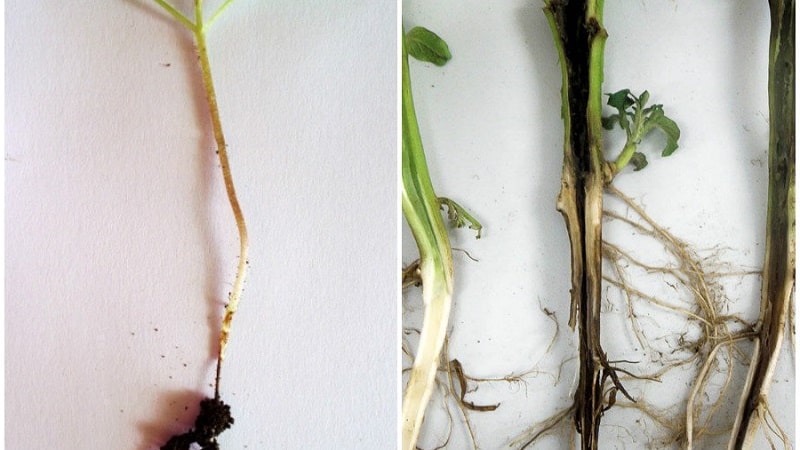
Infection occurs through plant debris or soil. Blackleg actively develops in stuffy and humid conditions.
For prevention, soil and seeds are disinfected before planting. a weak solution of potassium permanganate. Irrigation with Bordeaux mixture or copper sulfate solution helps cure fungal disease.
Gray rot
Gray rot appears as a light gray coating on fruits, flowers, leaves and stems. If action is not taken in time, the plaque turns into mold. As a preventative measure, use ventilation systems to ventilate the greenhouse and follow the planting pattern.

If the plant is sick, affected fruits and leaves are removed. The remaining peppers are sprayed with Fitosporin-M.
Cladosporiosis
Fungal disease occurs due to contaminated seeds, soil, plant residues. Fungal spores are transferred to garden tools and clothing. Gray-brown spots appear on the leaves and stems, which lead to the death and wilting of the plant.
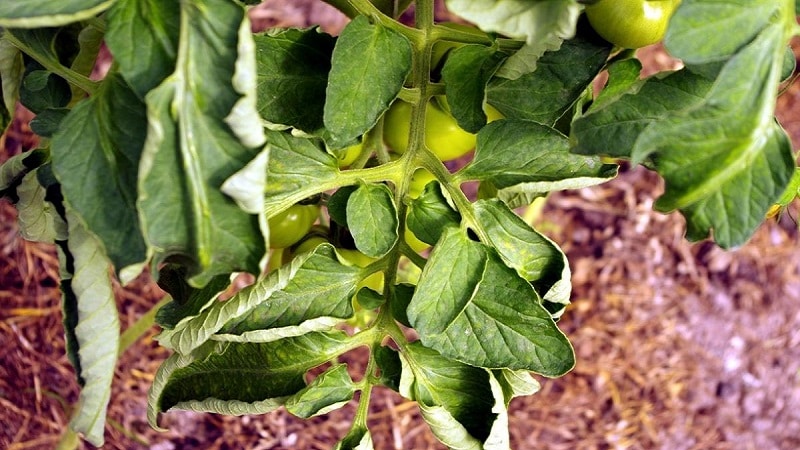
For prevention In the spring, the greenhouse is disinfected with a sulfur bomb and the beds for sweet peppers are changed annually. For treatment, the drugs “Barrier” or “Barrier” are used.
Late blight
Late blight fungus appears as brown spots. The plant becomes weak, the fruits are deformed, and rot appears.
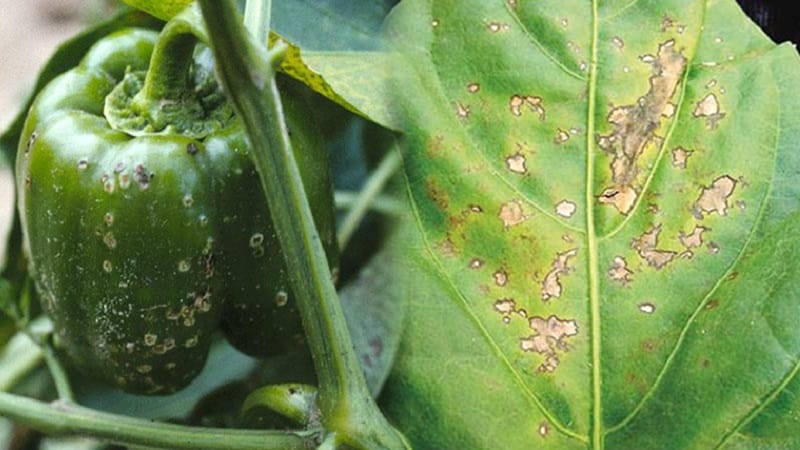
Late blight is treated with remedies "Diskor" or "Trichodermin". They get rid of fungus and increase the plant’s resistance to pathogens. For prevention, plants are sprayed with a solution of dry wood ash.
Important! Late blight can destroy up to 80% of the crop. Therefore, it is recommended to regularly inspect the beds and ventilate the greenhouse in a timely manner.
Phytoplasmosis
The disease appears at the tops and gradually spreads throughout the bush.. The plant turns yellow, the fruits become deformed and dry out. Phytoplasmosis occurs in a greenhouse due to insects - aphids and thrips. Experienced gardeners grow hybrids that are resistant to phytoplasmosis and regularly remove weeds and plant debris.
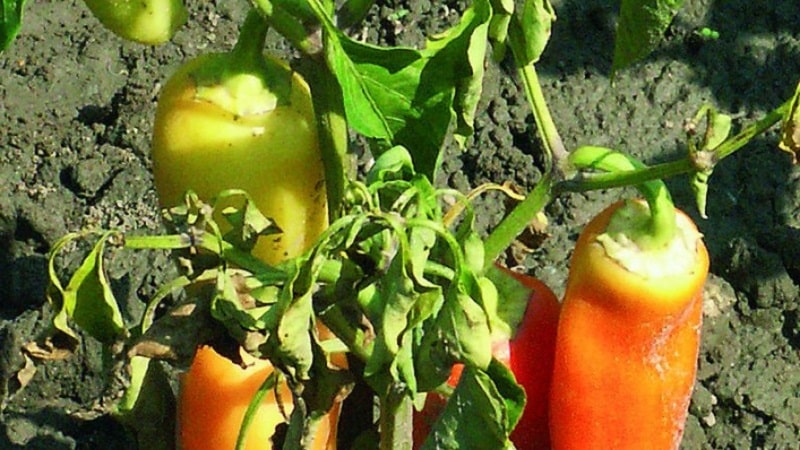
Treating fungus the drug "Agat-25K". It protects against diseases and increases productivity.
It can be useful:
When and how to plant peppers in a greenhouse correctly
Fusarium
Fusarium wilt affects the vessels of the plant, clogging them. The plant becomes sick, the leaves turn yellow and curl.For prevention, planting density is maintained, Fusarium wilt-resistant varieties and hybrids are planted, and the beds are sprayed with boron solution.
Treat the disease Vectra or copper sulfate solution.

White rot
White rot affects the base of the stem. Due to the fungal coating, seals are formed that poison the entire plant. White rot develops due to low temperatures, humidity, frost and rain.

For prevention The beds are watered only with warm water, and the plants are sprayed with a solution of whey and iodine once a week. The affected bushes are removed, the remaining ones are treated with the drug “Maxim”.
Powdery mildew
Disease appears as a white coating on stems and fruits. Occurs in greenhouses and greenhouses. Light spots become larger over time, and the peppers fade. The reasons for the appearance are heat, humidity and an excess of mineral supplements.
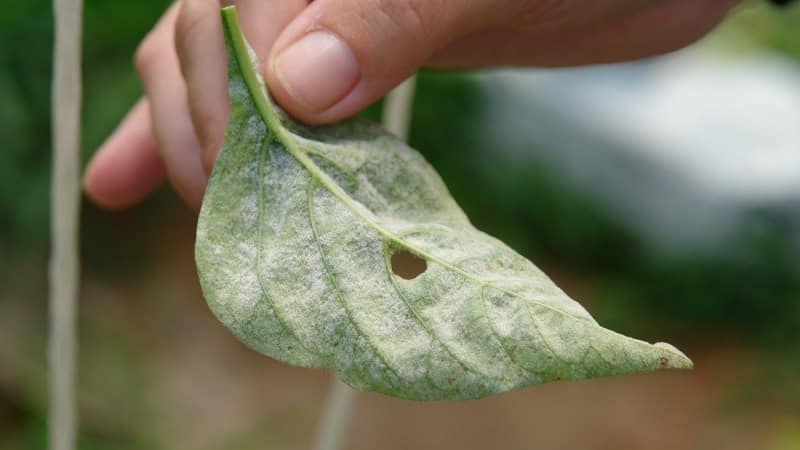
In case of infection gardeners spray the beds with the preparation “Gamair” and wipe the walls of the greenhouse with a weak solution of potassium permanganate.
Verticillium wilt
Occurs due to a lack of nitrogen and phosphorus. The disease develops quickly, in 2-3 days all bushes become pale and weak. The leaves acquire a corrugated, uneven surface, and fruit formation is reduced.

Used for treatment the drug "Maxim", for prevention - spraying based on herbs or onion peels.
Bacterial
Bacteria live on weeds, plant debris, seeds. Let's look at common bacterial diseases of greenhouse peppers.
Bacteriosis
Affected plants may die within 2-3 days. The leaves acquire a pale yellow tint, the fruits become deformed and lose their taste.Bacteriosis often occurs in heavy soils with high acidity.
For prevention maintain planting density, plant peppers on light and fertile lands. Bacteriosis is treated with Oxychom.
Dry spotting
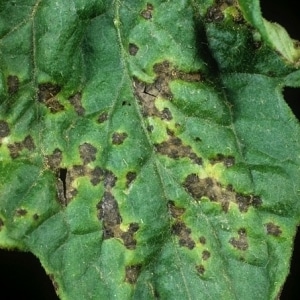 Large dark brown spots appear on the lower leaves. After 1-2 days the bushes dry out. Brown rings and small sores appear on the stem. The fruits near the stalk crack and watery spots appear.
Large dark brown spots appear on the lower leaves. After 1-2 days the bushes dry out. Brown rings and small sores appear on the stem. The fruits near the stalk crack and watery spots appear.
When the first signs are detected plants are treated with a weak solution of potassium permanganate or copper sulfate. If the bush has dried out, it is removed from the garden bed, and the remaining plants are treated with the drug “Fitosporin”.
Black spot
 Small spots of light green hue appear on the leaves. Over time, they turn black and grow.
Small spots of light green hue appear on the leaves. Over time, they turn black and grow.
Black bacterial spot affects young peppers and plants during the fruiting period.
For prevention purposes Before planting, the seeds are treated with a solution of succinic acid and germinated in damp, warm gauze. Plants are treated with Oxyhod.
Lightning Wither
The name of the disease speaks for itself - within a few days the plant turns yellow and dies. White mucus forms in the stem. Bacteria clog blood vessels, blocking the access of nutrients.
For prevention follow the rules of crop rotation - do not plant peppers in the same place for more than two years in a row. Lightning wilt is treated by spraying with a solution of copper sulfate.
Important! If it is not possible to plant peppers in different greenhouses, gardeners change the soil every season before planting.
Bacterial rot
The disease affects fruits, leaves, stems. Bacteria block access to vitamins and moisture, which is why the bushes become covered with a light coating and mucus and fade over time. Brown sores appear near the stalks.
Treat bacterial spot drug "Ordan". As a preventive measure, seeds are treated and disease-resistant varieties are selected.
Bacterial cancer
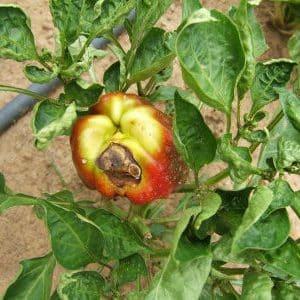 Causes of infection: humidity, heat, dense planting. Bacterial cancer is transmitted by insects, weeds, and garden tools. Asymmetrical spots appear on the affected leaves, with a white center and a brown border.
Causes of infection: humidity, heat, dense planting. Bacterial cancer is transmitted by insects, weeds, and garden tools. Asymmetrical spots appear on the affected leaves, with a white center and a brown border.
Diseased plants are removed, healthy ones are sprayed with Bordeaux mixture. Subsequently, after harvesting, the soil in the greenhouse is replaced.
Viral infections
Infectious agents are viruses that live with plant cells. Without cells, viruses cannot develop on their own.
Apical rot
Occurs due to an excess of nitrogen and a lack of calcium. Brown spots appear near the top of the fruit, which become moist over time.

For prevention comply irrigation mode and fertilizing, organize balanced fertilizers. During the season, peppers are fed with calcium nitrate 2-3 times.
Tobacco mosaic
Tobacco mosaic virus appears as a yellow pattern on the leaves. Favorable conditions for the development of the disease are dim light and high humidity. Infection occurs through gardening tools, seeds, and soil. Over time, the leaves turn black, become deformed and fall off.
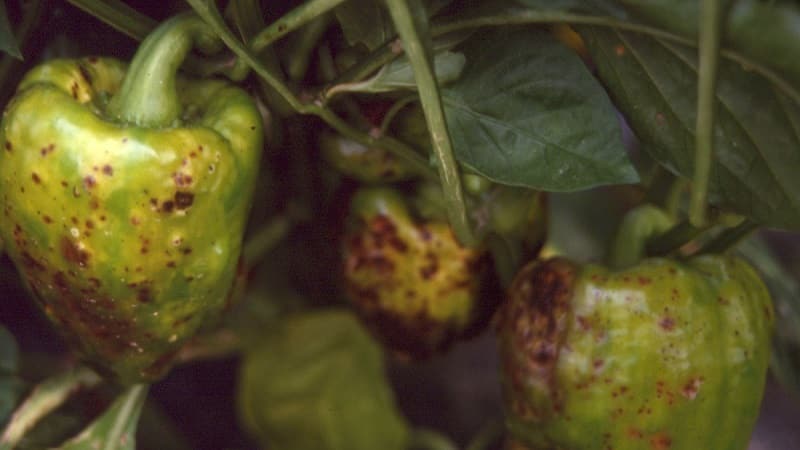
For prevention use a solution of water and milk. Tobacco mosaic is treated with colloidal sulfur.
Curly
Curly affects the leaves - they curl and become deformed. The virus infects mature plants.For treatment, the drugs “Aktara” or “Fitoverm” are used.
When signs are detected If there is curliness, diseased plants are removed. For preventive purposes, resistant hybrids are chosen for cultivation.
Important! There are several types of curliness. Dwarfing entails stunted growth and deformation of small peppers. Due to brown curl, dark spots and ulcers appear on the plant. Yellow curl manifests itself in the form of deformation of leaves and shoots.
Bronzing
Disease expressed as spots of bronze and purple shades. Spots appear on leaves, shoots, petioles and peppers. The top of the bush dies. Bronzing is carried by insects - thrips and slugs.
For prevention remove weeds, spray the plants with a solution of onion peels. The virus is treated with the drug "Strobi".
Non-infectious lesions
The causes of non-infectious lesions are drafts, acidic soil, insect pests. Plants wither and turn yellow, fruits become deformed. The crop also gets sick due to a lack of minerals. A lack of nitrogen manifests itself in the form of drying of leaves, and of boron - in the death of inflorescences. A lack of fluorine leads to rot, and iron leads to a change in the color of the leaf blade.
Prevention of pepper diseases
Preventive measures help prevent the occurrence of viral, fungal and bacterial diseases.
Experienced gardeners advise:
- Before planting, dig up the soil, remove all weeds and plant debris.
- At the end of autumn, add liquid manure to the beds.
- In the spring, disinfect the structure using a sulfur bomb.
- Wipe walls, doors and other hard surfaces with Bordeaux mixture.
- Ventilate greenhouses daily.
- Inspect plants daily for external signs.
- Water the peppers with warm water.
- Apply balanced organic and mineral fertilizers.
- Remove weeds once a week.
- Loosen the beds.
Conclusion
Diseases appear both in wooden greenhouses and in polycarbonate structures. Why do peppers get sick? There are several reasons: improper care, contaminated seeds, climatic conditions. All diseases are divided into viral, fungal, bacterial and non-infectious.
It is important to detect signs of the disease in time and take therapeutic measures, for which they use professional medications or folk remedies.